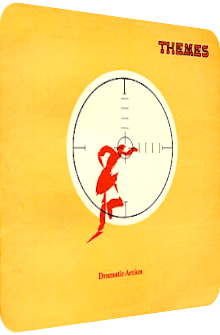
David Lindup & Johnny Pearson
Dramatic Action
1973
Dramatic Action, oh boy, that’s a review-worthy title! Released in 1973 on Alan Parker’s London-based library label Themes International Music which ran until the middle of the 80’s, the LP offers ten manifestations of Funk Exotica, realized by a surprising amount of textures and instruments, among them jungle flutes, kalimbas, bongos, clavichords and an organ galore. Side A is reserved for the unique compositions of David Lindup (1928–1992) while side B then is dedicated to the material of Johnny Pearson (1925–2011), with one additional track of percussionist Jim Lawless (born 1935) thrown in for good measure. Dramatic Action has many instruments on board, but its base frame is held together by electric guitars, horns and drums. The brass sections are slick, polished and surprisingly well-groomed.
In contrast to Lalo Schifrin’s brassterpiece New Fantasy (1964), Lindup & Pearson’s little artifact is downright tame, but what it lacks in incision, it showcases via a delicate spy atmosphere… or so it seems, for this topic is shoved aside often enough in order to also enchant listeners who are wary of this aural thrill. Another important ingredient is the mercilessly exotic flute that wafts through many a tune; its occasionally shrill, now and then warbled timbre injects a Latin fever, or even worse, a voodoo curse, an apposite inclusion given that Roger Moore started his Bond career in 1973 by investigating in Harlem, New York before venturing into the dark worlds of voodoo priests. Unsurprisingly, Dramatic Action is neither specifically attached to the Bond franchise nor inspired by Moore’s inaugural adventure in particular, but the composers cleverly absorb the melting pot of Post-Bop, Funk, the sunset phase of the illustrious big band orchestras and, cry me a river, the flamboyant genre called Exotica. And yet, I cannot recommend the album to the Exotica listener, no matter the luminosity of the compositions. Not because it’s library music. There is another – arrangement-related – reason which will be further explicated below.
An Interplay? That’s all you have to offer as an opener, Mr. Lindup? He has indeed, and granted, that title diminishes the grandiloquence that is about to unfold throughout the album. These thoughts notwithstanding, David Lindup boosts the funkiness as Interplay progresses, for at the end of the day, Interplay is no interlude. Launching with pentatonic flute sequences and bubbling bongos which evoke a Far Eastern atmosphere of excitement, the eponymous reciprocity kicks off staccato fanfares and is rounded off by downright languorous Reggae guitars. Once the electric bass enters the scenery, the lead trumpet goes wild and the feeling of being ahead of the competition – during a jungle chase for instance – absorbs the context. The Observer is next, and as its title so aptly implies: this is a sleazy, undercover critter. The electric drums are quite lively, the tempo, however, remains in midrange time and lets the concoction of jungular flutes and the nastily blazing horn flourish interact freely. Yes, this is an abhorrently cheesy choon, but the oscillating flute and the nocturnal aura make it worth the cheese connoisseur’s while. I know this firsthand.
The Aggressor, meanwhile, exposes the album’s weak point arrangement-wise, for its shapeshifting gyration between victorious elation, drum-infested augmentations and electric guitar coolness crystallizes the missing plasticity and depth of field of an otherwise catchy witches’ brew, whereas The Long Safari works better in this regard since its diorama is as plain as the steppe, if also bucolic and blotchy thanks to the great rally of kalimbas, Hammond organs and sundown guitar chords. The flute is yet again a distinct marker of exoticism, astutely amplifying the sense of being on a safari. Soul Survivor rounds off side A with a megacity downbeat and cavalcades of funky horns, warped organs and rotatory wah-wah guitars. The flute is a fife on this piece, mercilessly convulsing and asphyxiating. Wear your basecap and don’t forget your sunglasses, this is a concrete jungle, no rain forest.
Side B is reserved for the talent of Johnny Pearson and Jim Lawless. The first four songs offer a string of imaginative conquests deriving from Pearson’s feather. Even though his compositions are realized by the same session musicians and with the same amount of textures and instruments, his pieces are a tad more clever in terms of their stacked sinews which venture cautiously into the Third Stream movement without ever neglecting the accessibility and upbeat spirit. No Time To Hide shows this tendency if you listen closely. The electric guitar is obviously playfully ferocious, as is the fractalicious clavichord mélange, but the grafted Space-Age rain pads, the constantly morphing tone sequences and the sheer amount of simultaneous frequencies make this first track a less exotic and all the feistier take. Long Way To Go follows and is an extremely melodious hybrid of Exotica and tasteful Funk. The surfaces are pristine, the polyphonic guitars and the electric piano create the feeling of being on a stroll sunwards. Sylphlike and with the right amount of drum-accentuated yet distant pressure, this might well be the best song of the album!
Work Force then returns to an infinitesimally convoluted core. The pointillistic brass stabs and golden-shimmering melodies are embracing and wonderfully uplifting, but the gathering of the instruments is not always as harmonious, yet veneered enough by the protrusive reticulation to enthrall. Pearson’s last offering is the piercing Action Point, a Mandingo-like show tune supercharged with brass strata, helicoidal drums and that certain expectation of a magician entering the mental stage. It’s music for illusionists! Jim Lawless finishes side B with his sketch Action Assignment, an ebullient hybrid of a Honky Tonk piano alloy, organ blebs, rattling snakes and kalimba capsules. The electric guitars would be over the top, were they not tightly embedded in the streamlined cocktail of precipitance.
It is often unfair to judge a book by its cover. This also implies to an LP, for the calcined appearance of Dramatic Action is used as a marketing instrument and is of course furthermore caused by the razor-thing budgets with which labels of library music have to operate. However, when it comes to album titles, things look differently, for this is a domain where an artist has to say a thing or two, even if marketing buffs might annihilate the original thoughts that went into a title search often enough. Anyway, what I am hinting at is the following: Dramatic Action is way too bold a title for the presented material. Sure, a certain spy scheme cannot be denied, and yes, the use of electric guitars lets the material venture into the wild side often enough. This is still no classic record.
The instrumentation is flawless, the different textures, be they MIDI-based or not, are vivid and varied enough to capture the imagination, but the flattened appearance of the soundscapes is the album’s Achilles heel. Everything feels like a plateau, even valleys, wild rides and lethal hide-and-seek plots which are altogether implied by the album’s context and the implication of the titles. There is no sense of astriction or zoning, each instrument has to share its virtual place with every other foil or foe. This feeling of dense blandness (or bland density) is a feat in Pop productions, but not in terms of Funk Exotica. Fans of spy themes in general or Chaquito’s Spies & Dolls (1972) and said Mandingo’s Savage Rite (1975) in particular might risk a glimpse if they can find the album. The current rightsholder EMI, itself being the victim of other rightsholders, claims no interest in reissuing the LP, so eBay, GEMM and other market places remain one’s best bet.
Exotica Review 326: David Lindup & Johnny Pearson – Dramatic Action (1973). Originally published on Mar. 22, 2014 at AmbientExotica.com.
